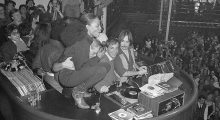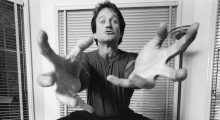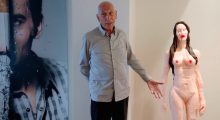Cinematographers
Interviews - Cinematographers
-
“I Am Not There to Call Attention to My Lighting:” DP Tom Hurwitz on Shooting Studio 54

Veteran cinematographer Tom Hurwitz has shot more than 100 documentary features and TV series since 1974, when he helped shoot The Grateful Dead, a concert film of the eponymous band live in San Francisco. Hurwitz has worked on such seminal series as Nova, Frontline and American Masters, while his feature doc work includes Wild Man Blues, The Queen of Versailles and last year’s Joan Didion: The Center Will Not Hold. Having worked on Valentino: The Last Emperor in 2008, Hurwitz again teams up with director Matt Tyrnauer for Studio 54, a doc on the legendary New York nightclub. Studio 54 makes its debut […]
-
DP Zak Mulligan on Shooting Sundance Drama We the Animals on Super 16mm

Cinematographer Zak Mulligan has worked on roughly 30 shorts, features, documentaries and TV series over the past decade. Mulligan served as DP on We the Animals, which premieres at the 2018 Sundance Film Festival as part of the NEXT lineup. The film marks the first narrative feature from Jeremiah Zagar, a documentary filmmaker whose 2008 In a Dream was shortlisted for an Academy Award and whose 2014 Captivated: The Trials of Pamela Smart screened in competition at Sundance. Below, Mulligan speaks with Filmmaker about blending digital and 16mm footage, stretching the number of shoot days and twisting his ankle on the set […]
-
Zoë White on Filming Christina Choe’s Feature Debut NANCY Starring Andrea Riseborough

Zoë White has DP’d more than 30 features and shorts since 2004, including Stephen Cone’s Princess Cyd and Onur Tukel’s Catfight. Her latest work, NANCY, marks the feature debut of Christina Choe, a writer/director whose shorts have screened at Telluride and SXSW. NANCY tells the story of a struggling writer (Andrea Riseborough) who tells elaborate lies on the Internet to compensate for her creative failures. The film co-stars Steve Buscemi, Ann Dowd and John Leguizamo. Below, White discusses how she and Choe arrived at the film’s visual design. NANCY screens in competition at the 2018 Sundance Film Festival. Filmmaker: How and why did you […]
-
“The Big Cameras Get Stopped in Security”: Alexandria Bombach on Shooting and Directing On Her Shoulders

Documentary filmmaker Alexandria Bombach released her debut feature, Frame by Frame, in 2015 to major acclaim on the festival circuit. The film screened at more than 30 festivals, including SWSX, Hot Docs, AFI Docs and the Camden International Film Festival, where it won the award for Best Documentary Feature. Bombach debuts her second feature, On Her Shoulders, in the U.S. Documentary Competition lineup at Sundance 2018. Below she discusses acting as her own cinematographer, the influence of Errol Morris’ Interrotron and filming in the “impossible heat” of a refugee camp in Athens. Filmmaker: How and why did you wind up being […]
-
DP Noah Greenberg on Chloë Sevigny and Kristen Stewart-Starring Lizzie Borden Drama Lizzie

The 1892 murder of Lizzie Borden’s father and stepmother has inspired numerous books, TV movies and even stage musicals but few feature films. That changes with the arrival of Lizzie from director Craig William Macneill. His film pairs two of the leading actresses of American independent cinema: Chloë Sevigny as Borden and Kristen Stewart as Bridget, her live-in maid and kindred spirit. Lizzie debuts in competition at the 2018 Sundance Film Festival. Prior to its premiere, Filmmaker spoke with cinematographer Noah Greenberg (Most Beautiful Island) about the film’s naturalistic (and claustrophobic) visual palette. Filmmaker: How and why did you wind up being […]
-
Documentary DP Tim Cragg on the Sensational Family Saga of Three Identical Strangers

Three men make a remarkable discovery in Three Identical Strangers, a new documentary premiering at Sundance from Tim Wardle. The men, all strangers, learn that they are in fact identical triplets separated at birth. Wardle chronicles this real-life saga through dramatizations from the ’70s and ’80s, present-day documentary footage and studio interviews. To shoot the film, Wardle hired Tim Cragg, a DP with more than 40 credits as a documentary cinematographer. Cragg spoke with Filmmaker ahead of the film’s six screenings at Sundance about the challenges of filming Three Identical Strangers. Filmmaker: How and why did you wind up being […]
-
Kamau Bilal on Serving as Director and DP for Documentary Short Baby Brother

Missouri-based filmmaker Kamau Bilal chronicles his brother’s move back home to his parents’ house in Baby Brother, a documentary short that premiered at the 2018 Sundance Film Festival. A documentary DP, editor and director, Bilal’s recent work includes shooting Abortion: Stories Women Tell for HBO. Below, Bilal discusses the traits of a “cinematic film,” the influence of Ramin Bahrani’s Chop Shop and his concerns on exploiting a documentary subject. Filmmaker: How and why did you wind up being the cinematographer of your film? What were the factors and attributes that led to your being hired for this job? Bilal: For this film I operated […]
-
Stop-Motion DP Tristan Oliver on Creating a Behind-the-Scenes VR Short for Wes Anderson’s Isle of Dogs

UK-based cinematographer Tristan Oliver has worked on stop-motion features, shorts, music videos and commercials for more than 20 years. Oliver served as DP on Fantastic Mr. Fox, Chicken Run and Wes Anderson’s forthcoming Isle of Dogs. For that last feature, Anderson also tapped Oliver to shoot a VR short on the making of the film, which enters theaters on March 23. Oliver spoke with Filmmaker about the cameras used on the film, translating Anderson’s aesthetic to stop-motion and the film as “an homage to Japanese cinema.” The short will screen as part of Sundance’s New Frontier program. Filmmaker: How and why […]
-
“The Art of Silently Weeping While Pulling Focus at the Same Time”: DP Nick Higgins on Shooting Robin Williams: Come Inside My Head?

Following Water & Power: A California Heist in 2017 and Roman Polanski: Wanted and Desired in 2008, Marina Zenovich returns to Sundance for a third time with Robin Williams: Come Inside My Mind, her documentary on the late comedic maestro. Documentary DP Nick Higgins served as one of four cinematographers on the project. Higgins was the sole DP on O.J.: Made in America and has more than 50 cinematography credits to his name. Below, he shares his thoughts on lighting documentary subjects and why he prefers to shoot interviews with a single camera. Robin Williams: Come Inside My Mind screens four times at Sundance 2018. Filmmaker: […]
-
“Documentaries Are Less an Act of Creation and More an Act of Discovery”: DP Bob Richman on The Price of Everything

Brooklyn-born DP Bob Richman began his career as a production assistant for Albert and David Maysles. He’s since gone on to shoot some of the most widely seen documentaries of the past 20 years: An Inconvenient Truth, Waiting for ‘Superman’, the Paradise Lost trilogy and Metallica: Some Kind of Monster, to name a few. His latest feature, The Price of Everything, is a vérité doc on the puzzlingly astronomical price of fine art. Richman spoke with Filmmaker ahead of the film’s Sundance premiere about his preferred camera for vérité filmmaking, reuniting with director Nathaniel Kahn (My Architect) and the essential importance of a good […]










